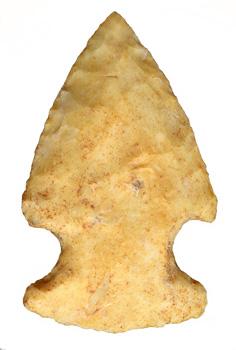

Point Type: GRAND
Also See: Big Creek, Carter, Cupp,
Epps, Ferry
, Gibson, Helton, Hopewell -
Snyders, Kirk Corner
Notched, Lost Lake, Lundy, Motley, Snyders
Location: South Central and North Central United States
Associated Dates: 2900 - 1500 B.P. - Woodland
Morphology: Corner
Notched
General Description: The Grand type
is a medium sized, corner notched point which has a short broad blade, barbed shoulders and a wide short stem. The
blade is broad, thin and triangular with convex sides. Shoulders have pronounced
barbs. Stems are short and very broad and
expand due to the notch form and resemble a dove's tail. Basal thinning was performed by removing
a few longitudianl flakes from each face of the stem and these flakes generally
extend to or above the notch area. The basal edge was dulled by light crushing and
is convex. Tangs are usually sharp on most specimens. Notches enter from
the corners, diagonally, some are curved upwards and can be deep and U
shaped.. Most notches are two-thirds as wide as they are long.
The
distribution area of the Grand type in not fully understood but it appears to
not be large. Most points are found in the four-corners area of Oklahoma,
Arkansas, Missouri and Kansas and are encountered in small numbers.
The
cultural affiliation of the Grand point type is not clearly understood.
The first examples reported were found in a pre-pottery level with Late Archaic
occupational debris. The point has some flaking characteristics of the
Afton point type but is thought to be somewhat later, probably dating from 2900
B.P. in northeastern Oklahoma.
I could find no size data on
the Grand point type.
According
to Gregory Perino, "the Grand point is thin, and the thinness was
maintained even after resharpening had occured several times. Its orginal
configuraiton, thinness and sharpness may indicate that it was used more often
as a knife rather than a projectile point. The type was defined on the
basis of only two points being found in a rock shelter, one of which was
broken. The broken point appears to have a slightly expanded stem.
The point can appear at times to be more basally notched than corner
notched.
According to Justice, "the Grand
type is a morphological
correlate of the Snyders Cluster".
The Grand Point was named by David
Baerreis and John Freeman in 1959 from specimens found near the Grand River in
northeastern Oklahoma.
About The Point Above (Shown Twice Size): The Grand point pictured at the top left of this page, was found in Wyandotte County, Kansas. It appears to be made of a white to cream colored chert which has some heavy creek stain. The point is weathered and appears polished due to erosion. Many knapping scars are heavily smoothed. The point is 48 mm long, 30 mm wide, stem width at the barbs is 17.7 mm and basal width is 28 mm. The stem length is 17 mm. Thickness is 7.5 mm at the neck of the stem. The point appears to have lead an interesting life and in heavily resharpened such that the barbs are pretty much gone and the basal edges are historically chipped. There is no basal grinding on the stem and it appears to be smoothed possibly due to weathering. Catalog Number 177-23-Y
References: Hranicky (1), Justice (1), Overstreet, Perino (4)
© Copyright 1997 - 2009 LITHICS-Net WWW.LITHICSNET.COM
Use your Browser's BACK Button to return to the LITHICS-Net Index.